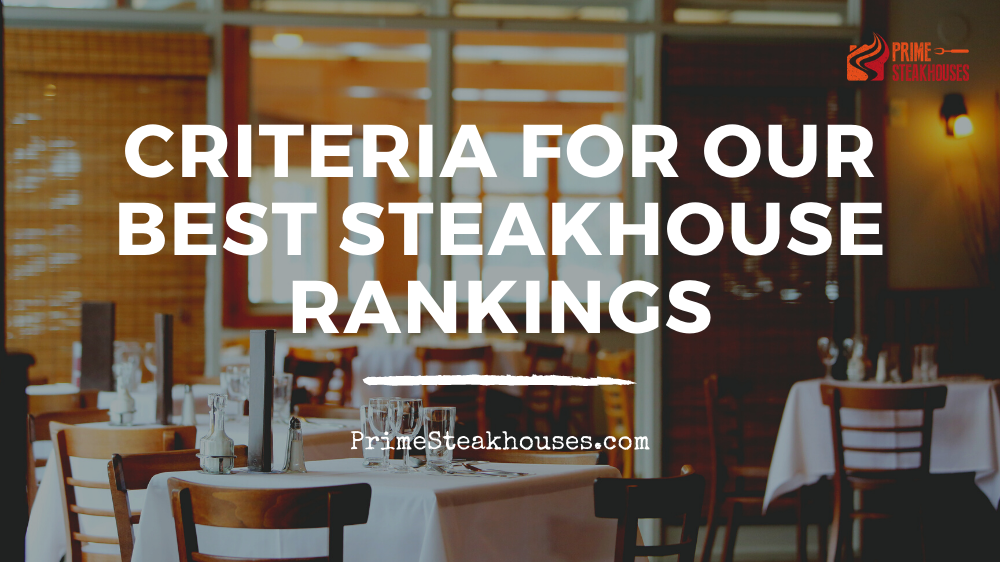To me, a brilliant steakhouse is a healthy compilation of rich wood mahogany, brass railings, sunken velveteen booths, dim lighting, dirty martinis, red wine, precision yet personable service, topped off by a mouth-watering steak. Not to mention the side dishes, never overlook the array of suitors on offer to transcend your dining experience.
The problem is that my assessment of a great steakhouse is subjective to my personal taste. To properly assess the best steakhouses across the United States, a benchmark assessment criteria must be set to ensure each steakhouse gets a fair trial.
We have created a Steakhouse Scorecard to measure two key categories: The Steak and The Steakhouse. Let’s step through this scorecard and explain the key criteria considered when ranking the best steakhouses across America.
Category One: The Steak
A steakhouse without steak is like a fish out of water. The two go hand-in-hand. Therefore when judging a steakhouse, it is essential to turn the spotlight on the steak itself. Refer to the table below for a detailed breakdown of the key criteria we use to measure the steak from our best steakhouses.
| Criteria | Factors Considered |
|---|---|
| Ethical Sourcing | Steakhouses are judged on the entire supply chain. Steak is ideally sourced from established and reputable family ranches across the United States. There are exceptions when steak will be sourced from renowned international farms. The criteria of a quality ranch are determined by their dedication to healthy cattle feeding and by meeting all Beef Quality Assurance (BQA) Animal Care and Well-Being Standards. Factors that make ethical farming include: – Trained animal handlers that know low-stress animal handling techniques – Cattle are given ample room to roam – On-call veterinarians. |
| Beef Grades | Most beef produced is graded for quality by the US Department of Agriculture (USDA). A good steakhouse will sell USDA prime beef. Abundant marbling from young, well-fed cattle is a key characteristic of prime beef. Another grading you may come across is USDA choice. This beef has less marbling and can be tough when overcooked. |
| Aging Process | Steak can either be dry or wet-aged. Dry aging is the more traditional process of taking a piece of meat and putting it into a controlled, open-air environment to transform in flavor. A good steakhouse will dry age the steak on-site. Meat is usually dry-aged for 20 to 28 days. Dry aging timeframes are at the discretion of the steakhouse. Wet aging is a more modern approach to aging meat. In this process, the meat is vacuum-sealed and stored in a fridge to age for approximately 14 days. This aging process is often used for packaging meat sold in retail settings. |
| Butcher | Assesses whether the steakhouse has an in-house butcher to hand-cut steaks. |
Category Two: The Steakhouse
The steakhouse itself creates a scene or mood in which the steak is devoured. Imagine a USDA prime steak consumed when smothered with tomato sauce, under a fluorescent light, with a can of coke to wash it down – that is sacrilegious.
The table below sets out all the criteria factored in when measuring the best-of-the-best steakhouses across the United States.
| Criteria | Factors Considered |
|---|---|
| Menu | This criterion assesses the menu to ensure accompanying dishes complement the steak – for example, signature sides, sauces, and decadent sauces. |
| Service | Service factors in the type of dining experience. Service can be a la carte, buffet, and private dining. Another service criteria considered is valet parking. |
| Beverages | The beverage list is ranked by reviewing the drinks available to compliment a diner’s meal. For example, signature cocktails, exclusive wine lists, and onsite cellars are factored into judging the overall steakhouse experience. |
| Price Range ($$-$$$$) | The price point is a key criterion factored in when ranking a steakhouse. Price determines the overall value. Steakhouses can range from budget to high-end. |
| Ambiance | Ambiance measures the type of dining atmosphere the steakhouse has created – for example, western, casual, and fine dining. |
Online Reputation  | The online reputation criteria aggregate ratings from across multiple platforms and will average them out to grade overall customer feedback. The rating scale is A+, A, A-, B+, and B. The top-rated steakhouses receive an A+ rating, and the lowest rating steakhouses receive a B. Note: there are no C or D grades because only the best steakhouses are measured. |
Our Guides
We’ve ranked the top steakhouses in the following cities & locations:
Final thoughts
When it comes to your steakhouse of choice, it all boils down to personal preference. Our Steakhouse Scorecard is a great way to quickly assess the key criteria to consider when planning your next visit to a steakhouse.
This scorecard helps you to determine that a steakhouse will meet your basic needs. For example, if you want to ensure you are getting top quality steak, now you can review Category One: The Steak and weigh up the findings. Whereas, if you value others’ opinions, you may prefer to focus on the Online Reputation criteria in Category Two: The Steakhouse.
Take comfort in knowing that every critical element has been included in our Steakhouse Scorecard. Now all you need to do is dig in and devour!
